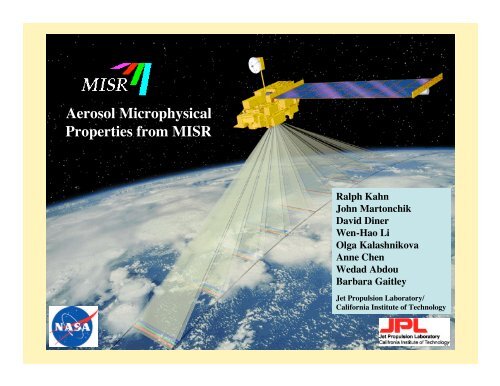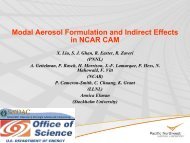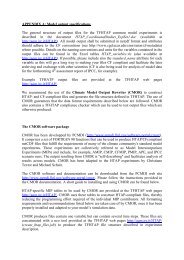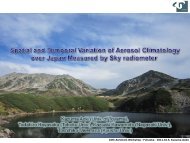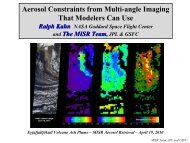Aerosol Microphysical Properties from MISR - AeroCom
Aerosol Microphysical Properties from MISR - AeroCom
Aerosol Microphysical Properties from MISR - AeroCom
Create successful ePaper yourself
Turn your PDF publications into a flip-book with our unique Google optimized e-Paper software.
<strong>Aerosol</strong> <strong>Microphysical</strong><br />
<strong>Properties</strong> <strong>from</strong> <strong>MISR</strong><br />
Ralph Kahn<br />
John Martonchik<br />
David Diner<br />
Wen-Hao Li<br />
Olga Kalashnikova<br />
Anne Chen<br />
Wedad Abdou<br />
Barbara Gaitley<br />
Jet Propulsion Laboratory/<br />
California Institute of Technology
<strong>MISR</strong> MULTI-ANGLE CAPABILITY –<br />
MORE INFORMATION ABOUT AEROSOLS<br />
EXPECATIONS based on simulations over cloud-free, calm ocean:<br />
• <strong>Aerosol</strong> Extinction Optical Depth (τ a )<br />
-- to better than 0.05 or 20%, whichever is larger, under typical conditions, for common<br />
aerosol types except soot, even if the particle microphysical properties are poorly known.<br />
• Particle Size (r a )<br />
-- “Small,” “Medium,” and “Large” size discrimination over Accumulation Mode --<br />
these are the key distinctions needed to assess aerosol impact on vis spectrum<br />
• Single Scattering Albedo – two-to-four groups at about 1.0, 0.9, and 0.8<br />
• Spherical vs. Nonspherical for Sahara dust, Asian dust, and possibly thin cirrus<br />
Under good conditions, we expect <strong>MISR</strong> to distinguish about 12 aerosol types based on size, shape, and<br />
composition
Simulated<br />
Global, Monthly<br />
<strong>Aerosol</strong> Maps<br />
Based on Expected<br />
<strong>MISR</strong> Sensitivity<br />
From: Kahn et al., 2001
Nine view angles at Earth surface:<br />
70.5º forward to 70.5º aft<br />
Four spectral bands at each angle:<br />
446, 558, 672, 866 nm<br />
Seven minutes to observe each<br />
scene at all 9 angles<br />
400-km swath<br />
Eight-day global coverage<br />
(two days near poles)<br />
275 m - 1.1 km spatial sampling
<strong>MISR</strong> MULTI-ANGLE AEROSOL RETRIEVAL STRENGTHS –<br />
• Ability to retrieve <strong>Aerosol</strong> Optical Thickness (AOT) over Land<br />
• Ability to retrieve AOT over Very Bright Surfaces (e.g., Desert)<br />
• Ability to retrieve AOT for Optically Thin hazes over land and water<br />
• Ability to retrieve Particle Sphericity at least over dark water<br />
• Ability to retrieve Three-to-Five Size Groupings at least over dark water<br />
• Crude Sensitivity to Single-Scattering Albedo [~ 1.0 vs. 0.88 vs. 0.80 over dark water]<br />
• Ability to retrieve Bi- and even Tri-modal Distributions in some cases<br />
• Ability to retrieve Plume Height; mainly useful in <strong>Aerosol</strong> Source Regions
<strong>MISR</strong> <strong>Aerosol</strong> Retrieval Algorithm Validation<br />
Aimed at determining quantitatively the unique contributions<br />
multi-angle imaging can make to aerosol science<br />
Must involve:<br />
• Critically testing and refining our algorithms<br />
• Quantitatively assessing the sensitivity of the best algorithms we can produce<br />
Then: Apply them to the global, multi-year <strong>MISR</strong> data set<br />
Supplemented by: More detailed surface and in situ data<br />
…to improve regional and global aerosol climatologies<br />
for aerosol budget and climate change applications
Scatter Plots Showing 579 <strong>MISR</strong>-AERONET Coincident AOT Events<br />
32 sites, during 2001-2002; Stratified by Expected <strong>Aerosol</strong> Type<br />
Overall:<br />
• About 2/3 fall within<br />
0.05 or 20% * AOT<br />
• About 1/3 fall within<br />
0.02 or 10% * AOT<br />
Correlation Coeffs. ><br />
0.8 in all categories<br />
except Dusty,<br />
which are > 0.72<br />
From: Kahn, et al., 2004, JGR (in press)
Sensitivity to aerosols over bright surfaces<br />
Thin haze over land<br />
is difficult to detect<br />
in the nadir view<br />
due to the<br />
brightness of the<br />
land surface<br />
nadir 70º<br />
Saudi Arabia,<br />
Red Sea,<br />
Eritrea<br />
Over Bright Desert Sites, mid-vis. AOT to ±0.07 [Martonchik et al., GRL 2004]
Smoke <strong>from</strong> Mexico (<strong>MISR</strong>)<br />
2 May 2002<br />
<strong>Aerosol</strong>:<br />
Amount<br />
Size<br />
Shape<br />
Medium<br />
Spherical<br />
Smoke<br />
Particles<br />
0.0 1.2 -.25 3.00 0.0 1.0
Dust blowing off the Sahara Desert (<strong>MISR</strong>)<br />
6 February 2004<br />
<strong>Aerosol</strong>:<br />
Amount<br />
Size<br />
Shape<br />
Large<br />
Non-Spherical<br />
Dust<br />
Particles<br />
0.0 1.2 -.25 3.00 0.0 1.0
247 <strong>MISR</strong>-AERONET Coincident AOT Difference Plots<br />
Continental Sites; 2001-2002; Stratified by Season<br />
Rogers & Sevilleta -- Dust-like<br />
Kanpur & Shirahama -- <strong>MISR</strong> SSA too low<br />
Some outliers --> plumes<br />
From: Kahn, et al., 2004, JGR (in press)
132 <strong>MISR</strong>-AERONET Coincident AOT Difference Plots<br />
Dusty Sites; 2001-2002; Stratified by Season<br />
Dusty season MAM, JJ<br />
<strong>MISR</strong> Dust SSA too low<br />
Yulin, Nes Ziona -- polluted<br />
From: Kahn, et al., 2004, JGR (in press)
Representative shapes<br />
Irregular plates and grains:<br />
Random4,<br />
CIR=1.64<br />
Random5,<br />
CIR=1.93<br />
Random6,<br />
CIR=2.29<br />
Random1<br />
Random2<br />
Random3<br />
Representative shapes were constructed to<br />
match measured values of particle aspect<br />
ratio and circularity.<br />
(Kalashnikova et al., 2002, 2004)
SHAPE SENSITIVITY FOR MINERAL DUST<br />
Fraction mid-vis AOT of successful models is gray<br />
From: Kalashnikova et al., 2004, submitted
SIZE & COMPOSITION SENSITIVITY FOR MINERAL DUST<br />
Atmosphere mid-vis AOT = 60% Mode 1, 40% Mode 2 Atmosphere mid-vis AOT = 40% Mode 1, 60% Mode 2<br />
Mode 1 => r 0<br />
= 0.5 µm, σ =1.6<br />
Mode 2 => r 0<br />
= 2, 3, or 4 µm, σ =2.0<br />
% in model definitions are percent Hematitie<br />
Fraction mid-vis AOT of successful models is gray<br />
Atmosphere mid-vis AOT = 20% Mode 1, 80% Mode 2<br />
From: Kalashnikova et al., 2004, submitted
Cape Verde Islands, February 06, 2004<br />
Orbit 22006<br />
<strong>MISR</strong> <strong>Aerosol</strong> Products<br />
0.14 0.87 -0.20 1.0 0.90 1.0<br />
<strong>MISR</strong>-AERONET Spectral AOT Comparison<br />
Dust Directly over ARNT site<br />
New vs. Old <strong>MISR</strong> Dust Models<br />
From: Kalashnikova et al., SPIE, 2004
Cape Verde Islands, February 08, 2004<br />
Orbit 22035<br />
<strong>MISR</strong> <strong>Aerosol</strong> Products<br />
0.3 1.1 -0.3 0.5 0.9<br />
1.0<br />
<strong>MISR</strong>-AERONET Spectral AOT Comparison<br />
<strong>MISR</strong>-MODIS-ARNT<br />
New vs. Old <strong>MISR</strong> Dust Models<br />
From: Kalashnikova et al., SPIE, 2004
135 <strong>MISR</strong>-AERONET Coincident AOT Difference Plots<br />
Biomass Burning Sites; 2001-2002; Stratified by Season<br />
At the 0.025 - 0.05 AOT level --<br />
<strong>MISR</strong> SSA low during burning season<br />
From: Kahn, et al., 2004, JGR (in press)
SIZE AND SSA SENSITIVITY FOR BIOMASS BURNING PARTICLES<br />
Fraction mid-vis AOT of successful models is red, black, or gray<br />
From: Chen et al., to be submitted
Pollution Particle Amount, Size, and Single Scattering <strong>Properties</strong><br />
Galveston Bay near Houston, TX, September 12, 2002<br />
September 12, 2002<br />
<strong>MISR</strong> Research retrieval: mixtures of small & medium, spherical, low-absorbing particles<br />
558 nm AOT Component 1 Component 2 Component 3<br />
0.60 60% spherical r eff<br />
= 0.12 µm 35% spherical r eff<br />
= 0.26 µm 5% cirrus<br />
0.45 85% spherical r eff<br />
= 0.12 µm 15% spherical r eff<br />
= 0.57 µm --<br />
0.25 85% spherical r eff<br />
= 0.12 µm 15% spherical r eff<br />
= 0.57 µm --<br />
-- in agreement with field results measured upwind [Engle-Cox, Haymet, et al.]
DUST & BIOMASS BURNING SENSITIVITY STUDY SUMMARY<br />
• Simulated good but realistic viewing conditions over dark water –<br />
[cloud-free, wind speed 2.5 m/s; chisq ~ 1.5; AOT >~ 0.2]<br />
• For components contributing >20% to the total mid-vis AOT,<br />
<strong>MISR</strong> Can Distinguish:<br />
• Shape: Plates <strong>from</strong> grains <strong>from</strong> spheroids <strong>from</strong> spheres<br />
• Size: Three-to-Five Size Bins between D c ~ 0.2 and 2.5 µm<br />
• SSA: Weakly <strong>from</strong> strongly absorbing dust (~2% vs. 10% hematite)<br />
Also for spheres, can separate SSA ~ 0.75 <strong>from</strong> 0.85 <strong>from</strong> 0.95<br />
• Size discrimination for small-medium spheres- poorer for SSA
65 <strong>MISR</strong>-AERONET Coincident AOT Difference Plots<br />
Maritime Sites; 2001-2002; Stratified by Season<br />
<strong>MISR</strong> AOT high --<br />
Low-light-level calibration under study<br />
Ocean surface BC under study<br />
Outliers -- high winds--> whitecaps<br />
From: Kahn, et al., 2004, JGR (in press)
Selection criteria:<br />
Island events<br />
■ Isolated <strong>from</strong> major land (Case 1 waters)<br />
■ Mostly cloud-free<br />
■ High-quality AERONET retrieval<br />
■ AOT < 0.3<br />
■ AOT variability low<br />
■ Near-surface wind-speed low<br />
■ <strong>Aerosol</strong> air mass likely to be Clean Maritime<br />
Data collected for each event:<br />
■ Wind speed (local Met. Station, scatterometer)<br />
■ Wind speed variability (local Met. Station, scatterometer)<br />
■ Surface pressure (local Met. Station)<br />
■ Column ozone amount (TOMS)<br />
■ Airmass history (NOAA HYSPLIT)<br />
■ AOT (AERONET)<br />
■ AOT variation (AERONET time series)<br />
■ <strong>Aerosol</strong> refractive indices (AERONET)<br />
■ <strong>Aerosol</strong> size distribution (AERONET)<br />
Use Mie code to calculate SSA, Q ext , P(θ)
<strong>MISR</strong> Low-Light-Level Nadir Reflectance Inter-Comparison<br />
Clean Island Sites;MODIS-Land, MODIS-Ocean, AERONET+Model<br />
From: Kahn, et al., JAS, 2004 (in press)
<strong>MISR</strong>-RETRIEVED AOT WITH & WITHOUT<br />
BAND + CAMERA CALIBRATION ADJUSTMENTS<br />
From: Kahn, et al.,JAS, 2004 (in press)
<strong>MISR</strong> and AERONET Spectral AOT by Expected <strong>Aerosol</strong> Type<br />
From: Kahn, et al., JGR, 2004 (in press)
Multi-Modal Distributions and Particle Sphericity<br />
<strong>MISR</strong> Research retrieval Identified<br />
Three aerosol components:<br />
• Thin Cirrus<br />
- confirmed by MAS instrument<br />
• Background Maritime<br />
- medium, spherical, non-absorbing<br />
• Sahara Dust<br />
- predicted by NAPS model<br />
- measured by PALMS<br />
CRYSTAL- FACE July 9, 2002<br />
Optical depth (558 nm) = 0.20<br />
35% cirrus<br />
50% small spherical non-absorbing<br />
15% dust<br />
Kahn et al., 2004, in preparation
127 <strong>MISR</strong>- AERONET & 113 MODIS-AERONET Coincident AOT Comparisons<br />
Over Land; March, June, and September 2002<br />
From: Abdou, et al., 2004, JGR (in press)
NEAR-TERM UPGRADES TO THE <strong>MISR</strong> AEROSOL RETRIEVAL<br />
STANDARD ALGORITHM (VERSION 16 +)<br />
• More realistic Mineral Dust optical models<br />
• Additional, Darker Spherical Pollution and Biomass Burning analogs<br />
• A Richer Selection of Bi-modal Mixtures<br />
+ Refined <strong>MISR</strong> Radiometric Calibration,<br />
affecting <strong>MISR</strong> low-light-level <strong>Aerosol</strong> Retrievals<br />
Upgrades should reduce remaining discrepancies with sun photometers<br />
by at least half.<br />
<strong>MISR</strong> data available <strong>from</strong> the NASA Langley Atmospheric Sciences Data Center:<br />
http://eosweb.larc.nasa.gov/
RECENT <strong>MISR</strong> AEROSOL VALIDATION TEAM PUBLICATIONS<br />
Kahn, R., B. Gaitley, J. Martonchik, D. Diner, K. Crean, and B. Holben, 2004, <strong>MISR</strong> global aerosol optical depth validation based on two years<br />
of coincident AERONET observations, J. Geophys. Res., doi:jd004706R, in press.<br />
Abdou, W.A., D.J. Diner, J.V. Martonchik, C.J. Bruegge, R.A. Kahn, B.J. Gaitley, K.A. Crean, L.A. Remer, and B. Holben, 2004, Comparison<br />
of coincident <strong>MISR</strong> and MODIS aerosol optical depths over land and ocean scenes containing AERONET sites, J. Gelphys. Res., in press.<br />
Kalashnikova, O.V., R.A. Kahn, and W-H. Li, 2004, The ability of multi-angle remote sensing observations to identify and distinguish mineral<br />
dust types: Part 2. Sensitivity data analysis, J. Geophys. Res., submitted.<br />
DiGirolamo, L., T.C. Bond. D. Bramer. D.J. Diner, F. Fettinger, R.A. Kahn, J.V. Martonchik, M.V. Ramana, V. Ramanathan, and P.J. Rasch,<br />
2004, Analysis of Multi-angle Imaging SpectroRadiometer (<strong>MISR</strong>) aerosol optical depths over greater India during winter 2001-2004,<br />
Geophys. Res. Let., in press.<br />
Diner, D.J., J.V. Martonchik, R.A. Kahn, , B. Pinty, N. Gobron, D.L. Nelson, and B.N. Holben, 2004, Using angular and spectral shape<br />
similarity constraints to improve <strong>MISR</strong> aerosol and surface retrievals over land, Remt. Sens. Environ., in press.<br />
Bruegge, Carol J., Wedad A. Abdou, David J. Diner, Barbara J. Gaitley, Mark C. Helmlinger, Ralph A. Kahn, and John V. Martonchik, 2004,<br />
Validation of the <strong>MISR</strong> radiometric scale for the ocean aerosol science communities. Proceedings of the The International Workshop on<br />
Radiometric and Geometric Calibration, December 2-5, 2003, Gulfport, Mississippi. A.A. Balkema Publishers, Rotterdam, Netherlands.<br />
Kahn, R., W-H. Li, J. Martonchik, C. Bruegge, D. Diner, B. Gaitley, W.Abdou, O. Dubovik, B. Holben, S. Smirnov, Z. Jin, and D. Clark, 2005.<br />
<strong>MISR</strong> low-light-level calibration, and implications for aerosol retrieval over dark water, J. Atmosph, Sci., in press.<br />
Redemann, J., B. Schmid, J.A. Eilers, R. Kahn, R.C. Levy, P.B. Russell, J.M. Livingston, P.V. Hobbs, W.L. Smith, Jr., and B.N. Holben, 2004,<br />
Suborbital measurements of spectral aerosol optical depth and its variability at sub-satellite-grid scales in support of CLAMS, 2001, J.<br />
Atmosph. Sci., in press.<br />
Kalashnikova, O.V., R. Kahn, I.N. Sokolik, and W-H. Li, 2004, The ability of multi-angle remote sensing observations to identify and<br />
distinguish mineral dust types: Part 1. Optical models and retrievals of optically thick plumes, J. Geophys. Res., in press.<br />
Martonchik, J.V., D.J. Diner, R.A. Kahn, B.J. Gaitley, and B.N. Holben, 2004, Comparison of <strong>MISR</strong> and AERONET aerosol optical depths over<br />
desert sites, Geophys. Res. Let.,31, doi:10.1029/2004GL019807.<br />
Kahn, R., and 39 co-authors, 2004, Environmental snapshots <strong>from</strong> ACE-Asia. J. Geophys. Res. Doi:2003jd004339.<br />
Kalashnikova, O.V., D.J. Diner, R.A. Kahn, and B. Gaitley, Dust aerosol retrieval results <strong>from</strong> <strong>MISR</strong>, 2004, Proc. SPIE, Fourth Intern. Asia-<br />
Pacific Environ. Remt. Sens. Symp. Nov. 8-11.
Key Question…<br />
What must each component:<br />
• Satellites<br />
• In Situ & Surface Observations<br />
• Transport Models<br />
bring to the table, and how must these inputs be<br />
combined, to produce a sufficiently accurate and<br />
complete global aerosol/cloud picture to understand<br />
<strong>Aerosol</strong> Climate Impacts?<br />
Ref. -- The “PARAGON” papers, BAMS, October 2004
Pollution <strong>Aerosol</strong> Concentrated<br />
in Ganges Valley near Kanpur, India (<strong>MISR</strong>)<br />
<strong>MISR</strong> mid-visible AOD<br />
[Winter, 2001-2004; white --> AOD >0.6]<br />
NCEP Winds + Topography<br />
[Black=surface; Red=850 mb;<br />
contours=vertical, solid=subsidence]<br />
L. DiGirolamo et al., GRL, 2004, in press
<strong>MISR</strong> EARLY POST-LAUNCH<br />
COMPONENT AEROSOL OPTICAL MODELS<br />
(VERSION 15)<br />
#<br />
Component<br />
Name<br />
r 1<br />
(µm)<br />
r 2<br />
(µm)<br />
r c<br />
(µm)<br />
1 sph_nonabso<br />
rb_0.06<br />
0.001 0.4 0.03<br />
2 sph_nonabso<br />
rb_0.12<br />
0.001 0.75 0.06<br />
3 sph_nonabso<br />
rb_0.26<br />
0.01 1.5 0.12<br />
4 sph_nonabso<br />
rb_0.57<br />
0.01 4 0.24<br />
5 sph_nonabso<br />
rb_1.28<br />
0.01 8 0.5<br />
6 nonsph_abso<br />
rb_1.18_lo<br />
0.05 2 0.47<br />
7 nonsph_abso<br />
rb_1.18_hi<br />
0.05 2 0.47<br />
8 nonsph_abso<br />
rb_7.48<br />
0.5 15 1.9<br />
9 sph_absorb<br />
_0.04 0.001 0.5 0.012<br />
r e<br />
(µm)<br />
σ<br />
SSA<br />
(446)<br />
SSA<br />
(558)<br />
SSA<br />
(672)<br />
SSA<br />
(866)<br />
0.06 1.65 1.00 1.00 1.00 1.00<br />
1.95<br />
0.12 1.7 1.00 1.00 1.00 1.00<br />
1.54<br />
0.26 1.75 1.00 1.00 1.00 1.00<br />
1.18<br />
0.57 1.8 1.00 1.00 1.00 1.00<br />
0.98<br />
1.28 1.85 1.00 1.00 1.00 1.00<br />
0.96<br />
1.18 2.6 0.805 0.880 0.914 0.980<br />
0.97<br />
1.18 2.6 0.805 0.880 0.914 0.980<br />
0.97<br />
7.48<br />
0.04<br />
2.6<br />
2.0<br />
0.612 0.694 0.734 0.900<br />
0.250 0.209 0.172 0.123<br />
AOT((446)<br />
/AOT(558) AOT(672)/ AOT(867)/<br />
AOT(558) AOT(558)<br />
1.00<br />
1.37<br />
g<br />
(558)<br />
Particle<br />
Size/Shape<br />
Category<br />
0.55 0.23 0.352 Small Spherical<br />
0.66 0.35 0.609 Small Spherical<br />
0.82 0.58 0.717<br />
0.99 0.91 0.722<br />
1.04 1.10 0.728<br />
1.03 1.08 0.730<br />
1.03 1.08 0.730<br />
Medium<br />
Spherical<br />
Large<br />
Spherical<br />
Large<br />
Spherical<br />
Medium Dust<br />
Low<br />
Medium Dust<br />
High<br />
1.00 1.00 0.881 Coarse Dust<br />
0.77 0.54 0.337 Black Carbon
<strong>MISR</strong> COMPONENT AEROSOL OPTICAL MODELS<br />
(VERSION 16+)<br />
Component<br />
Name<br />
r 1<br />
(µm)<br />
r 2<br />
(µm)<br />
r c<br />
(µm)<br />
sph_nonabsorb_0.06<br />
0.001 0.4 0.03<br />
sph_nonabsorb_0.12<br />
0.001 0.75 0.06<br />
sph_nonabsorb_0.26<br />
0.01 1.5 0.12<br />
sph_nonabsorb_2.80<br />
0.1 50 1.0<br />
sph_absorb_<br />
ssa0.9_0.12<br />
0.001 0.75 0.06<br />
sph_absorb_<br />
ssa0.8_0.12<br />
0.001 0.75 0.06<br />
grains_<br />
mode1_h1 0.1 1 0.5<br />
spheroidal_<br />
mode2_h1 0.1 6 1.0<br />
r e<br />
(µm)<br />
σ<br />
SSA<br />
(446)<br />
SSA<br />
(558)<br />
SSA<br />
(672)<br />
SSA<br />
(866)<br />
0.06 1.65 1.00 1.00 1.00 1.00<br />
1.95<br />
0.12 1.7 1.00 1.00 1.00 1.00<br />
1.54<br />
0.26 1.75 1.00 1.00 1.00 1.00<br />
1.18<br />
2.80 1.90 1.00 1.00 1.00 1.00<br />
0.99<br />
0.12 1.7<br />
0.91<br />
0.12 1.7<br />
0.82<br />
1.5<br />
2.0<br />
2.60<br />
2.60<br />
0.90 0.89 0.85<br />
0.80 0.77 0.72<br />
0.92 0.98 0.99 1.0<br />
0.81 0.90 0.97 0.98<br />
AOT(446)/<br />
AOT(558) AOT(672)/<br />
AOT(558) AOT(867)/<br />
AOT(558)<br />
1.48<br />
1.47<br />
0.90<br />
0.99<br />
g<br />
(558)<br />
0.55 0.23 0.352<br />
Particle<br />
Size/Shape<br />
Category<br />
Very Small<br />
Spherical<br />
0.66 0.35 0.609 Small Spherical<br />
0.82 0.58 0.717<br />
Medium<br />
Spherical<br />
1.02 1.06 0.776 Large Spherical<br />
0.68 0.37 0.612<br />
0.69 0.40 0.614<br />
1.06 1.08 0.711<br />
1.02 1.05 0.772<br />
Small Spherical<br />
Absorbing<br />
Small Spherical<br />
Very Absorbing<br />
Medium nonspherical<br />
dust<br />
Large nonspherical<br />
dust


